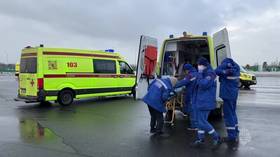Zelensky brands parts of Russia ‘historically’ Ukrainian
The president has listed six regions in a decree demanding that Ukrainian “national identity” be preserved inside the neighboring country
Ukrainian President Vladimir Zelensky declared six Russian regions to be “historically inhabited by Ukrainians” in a decree published on Monday. The list does not include any of the territory that Kiev claims sovereignty over in the ongoing conflict with Moscow, and focuses on globally recognized parts of Russia.
The document includes Bryansk, Kursk, and Belgorod regions, all of which border Ukraine. It also lists Voronezh, Rostov, and Krasnodar regions, all of which bordered Ukraine before 2014, when Crimea decided to join Russia in a referendum and the Donetsk and Lugansk People’s Republics declared independence from Kiev.
Zelensky claimed the population of these territories had been subjected to “the policy of forced Russification,” and ordered the government in Kiev to develop “an action plan” to “preserve” Ukrainian “national identity” in Russia.
The decree calls on Russia to “provide Ukrainians living in its territories” with access to education in the Ukrainian language, as well as access to Ukrainian-language mass media and special “civil, social, cultural, and religious rights.”
Moscow has never imposed any restrictions on the Ukrainian language. Russia’s education minister, Sergey Kravtsov, said in July 2022 that “no one was banning” it, and that it would be taught in schools where necessary.
Zelensky’s decree also tasks the Ukrainian government and the National Security and Defense Council with “collecting and studying facts and testimonies about crimes” supposedly committed against Ukrainians in Russia throughout its history, as well as “countering disinformation and propaganda” about Ukrainian history, allegedly spread by Moscow.
The president also instructed the Ukrainian Academy of Sciences to “prepare materials” on the “thousand-year-old history” of Ukraine and distribute them around the world. The country’s educational programs and textbooks should also contain “the true history of ethnic Ukrainians,” Zelensky added.
The Russian regions mentioned in the decree have repeatedly been targeted by Ukrainian missile and drone attacks as well as shelling since the start of hostilities with Moscow in February 2022. Zelensky’s decree comes just weeks after Kiev launched a major attack on the city of Belgorod. The strike, which according to the Russian Defense Ministry involved the use of banned cluster munitions, claimed the lives of 25 people, including children, and left more than a hundred injured.
In mid-January, a child was injured in a Ukrainian drone attack on the city of Voronezh – the capital of another region Zelensky claimed was “historically inhabited by Ukrainians.”
The developments come amid Kiev’s attempts to ban the Ukrainian Orthodox Church (UOC) – the country’s biggest Christian denomination, which is reported to have more than 8,000 parishes. The Ukrainian government has long accused it of having ties with the Russian Orthodox Church (ROC).
Russian President Vladimir Putin has repeatedly stated that Ukraine in its pre-2014 borders was largely “created” by the Soviet leadership over the course of the 20th century. Historically, “Ukrainian lands” included a much smaller territory, he has argued.
When the Cossacks living on the territory of modern Ukraine broke away from the Polish-Lithuanian Commonwealth in the 17th century following the Bogdan Khmelnitsky uprising and asked the then-Tsardom of Russia to take them in, the territory they controlled effectively amounted to present-day Kiev, Chernigov, and Zhitomir regions – three areas in the north of Ukraine, the Russian president said in 2022.







Comments are closed.